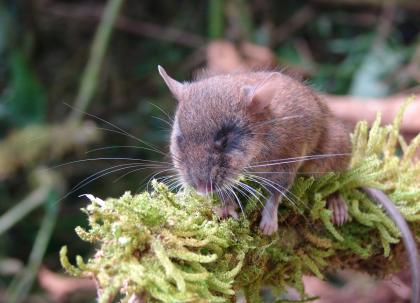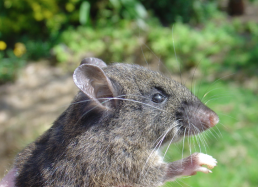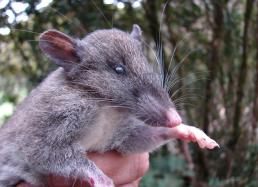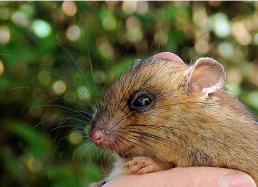7: Season's End
Well, the trip is over, and I’m back in Chicago. We obtained a small mountain of data that we'll work with for the next few months so that we can submit our formal report on mammalian biodiversity to Mt. Pulag National Park. We'll also use this data as the basis for technical and non-technical publications for many years to come.
Leaving the upper camp involved hiring 27 porters from the community around the ranger station and hauling everything down the mountain. It had rained overnight, so it took awhile to dry the tents, but we were on our way by about 10 AM, and we reached the station at about noon. We'd made arrangements for a jeepney to meet us there, so we immediately loaded the gear into the vehicle, took a few group photos with everyone, said our good-byes, and then headed down the mountain to Baguio. The road was easier to handle going down than up, and a whole lot better in a jeepney than on a motorcycle.
Overall, the trip was a great success; finding the bushy-tailed cloud rat to be common at our upper camp (in the mossy forest) was wonderful, and documenting the presence of the new species of tiny tree-mouse that we first discovered on Mt. Amuyao in 2007 was a great bonus for us (see the above photo). The bulk of the data will allow us to determine the impact of logging, clearing for agriculture, and burning on the native small mammal community of the mossy forest.
Our impression at this time is that several species—the Cordillera forest mouse (Apomys datae; see Photo #1 below), the silver earth-mouse (Chrotomys silaceus), and the Cordillera tweezer-beaked rat (Rhynchomys soricoides; see Photo #2 below)—are much more common in disturbed habitats than we'd expected. Even more strikingly, our data shows that the non-native pest rats do not survive away from houses and agricultural fields, unlike in some other parts of the world where these species are aggressive invaders of natural habitat. All of this is good news for conservation.
Once in Baguio, we learned that the press release we'd planned to announce the re-discovery of the dwarf cloud rat (Carpomys melanurus) had been changed into a full-fledged press conference with two TV stations, three newspapers, and some local magazines represented. Danny, myself, the park superintendent, and the Regional Executive Director for the DENR walked into the room with about 20 people waiting for us, and everyone looked at me.
So, I started talking. I’m not particularly comfortable in front of TV cameras, but I struggled on, trying to explain that: no, this was not one of the giant cloud rats that everyone knew about; no, it's not just a city rat that climbed into a tree; yes, the last time any scientist saw one was in 1896; it really is as cute as the photo makes it look (see Photo #3 below); and it really does live only in the mossy forest in the Central Cordillera. The information eventually was picked up by an international wire service, and people I know around the world sent me notes to let me know that they'd seen it.
The DENR people were delighted with the publicity for the park and said that they would adopt this species as their park mascot. My hope is that this will help to generate more ecotourism, and that the ecotourism will provide a counter-weight to the pressure to convert more mossy forest to vegetable fields. The need for healthy watersheds should be enough of an argument for protection—but I’ve learned that the more direct and immediate the rationale for conservation, the more likely it will be successful.
After a few days in Baguio to discuss our results with the DENR staff and to obtain the permits necessary to transport specimens to Manila, we hopped on one of the big buses. Once back in Manila, the usual desire to get everything completed and head home took over; we managed to obtain the export permits for our voucher specimens and got everything packed up quickly.
I always hate to leave behind good friends, but I surely am glad to be home. Danny will join me here in Chicago on about the 1st of September, and the next phase will begin, which includes writing our formal report to the Philippine DENR on Mt. Pulag's mammalian biodiversity. By then, I'll have also completed my online Interactive Map that will allow you to explore images of our findings on Mt. Pulag, as well as Mt. Amuyao and Mt. Data from expeditions in previous years. But for now, check out our Video Reports from the field, and the new images we've added to the Photo Gallery. They provide a lively overview of the Philippine Mammal Project and many of the species we found this year—Enjoy!
Larry








